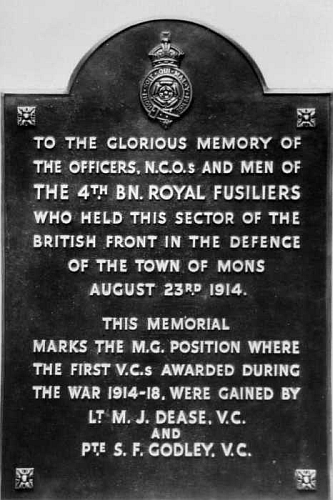Private Godley Sidney Frank V.C.
Medal & Mortality index
In the 1911 census, he is a private aged 21 at Aldershot, born in East
Grinstead, Sussex. Apparently, his surname is actually Godly.
l/13814 Private Sidney Frank Godley V.C. ; 4 Royal Fusiliers
The Edinburgh Gazette of 27 November 1914 confers the V.C. to :
13814 Private ; Sidney Frank Godley ; 4th Battalion The Royal Fusiliers, City of
London Regiment :
"For coolness and gallantry in fighting his machine gun under a hot fire for two
hours after he had been wounded at Mons on the 23rd August."
P.O.W. 27-4-1916
Private Sidney Frank Godley is the first private to win a Victoria Cross, and
during the Battle of the Mons. He becomes a prisoner of war until 1918, and he
is unaware of the gallantry award. When the war ends, he returns home to marry
in 1919. He spends much of his life after this time as a school caretaker in
Tower Hamlets until his death in 1957.
His VC group of medals is sold in 2012 for £230,000 by a family member at
Spinks auction.

The Memorial marks M.G. the position where the first V.C.'s awarded during the War 1914-1918 were gained by Lt M J Dease V.C. and Pte S F Godley V.C.
THE BATTLE OF MONS
The morning of the 23rd opened sunny and bright. The weather was set fair with a
breeze from the east, a cloudless sky, and the promise of great heat at midday.
A pale blue haze rounded off the distance, and softened the outlines of the
tall, gaunt chimney stacks with which the entire country is dotted.
The northern side of the canal is here dotted, throughout the entire length of
the attacked position, with a number of small fir plantations which proved of
inestimable value to the enemy for the purpose of masking their machine-gun
fire, as well as for massing their infantry preparatory to an attack.
About nine o'clock the German infantry attack, which had been threatening for
some time past, took definite shape and four battalions were suddenly launched
upon the head of the Nimy bridge. The bridge was defended by a single company of
the R. Fusiliers under Captain Ashburner and a machine-gun in charge of Lieut.
Dease.
The Germans attacked in close column, an experiment which, in this case proved a
conspicuous failure, the leading sections going down as one man before the
concentrated machine-gun and rifle fire from the bridge. The survivors retreated
with some haste behind the shelter of one of the plantations, where they
remained for half an hour. Then the attack was renewed, this time in extended
order. The alteration in the formation at once made itself felt on the
defenders. This time the attack was checked but not stopped. Captain Ashburner's
company on the Nimy bridge began to be hard pressed and 2nd Lieut. Mead was sent
up with a platoon to its support. Mead was at once wounded—badly wounded in the
head. He had it dressed in rear and returned to the firing line, to be again
almost immediately shot through the head and killed. Captain Bowdon-Smith and
Lieut. Smith then went up to the bridge with another platoon. Within ten minutes
both had fallen badly wounded. Lieut. Dease who was working the machine-gun had
already been hit three times. Captain Ashburner was wounded in the head, and
Captain Forster, in the trench to the right of him, had been shot through the
right arm and stomach. The position on the Nimy bridge was growing very
desperate, and it was equally bad further to the left, where Captain Byng's
company on the Ghlin bridge was going through a very similar experience. Here
again the pressure was tremendous and the Germans made considerable headway, but
could not gain the bridges, Pte. Godley with his machine-gun sticking to his
post to the very end, and doing tremendous execution. The defenders too had most
effective support from the 107th Battery R.F.A. entrenched behind them, the
Artillery Observer in the firing line communicating the enemy's range with great
accuracy.
The retirement of the R. Fusiliers from their dangerous position along the
western boundary of the salient was not an easy matter. Before cover could be
got they had to cross 250 yards of flat open ground swept at very close range by
shrapnel and machine-gun fire. Dease had now been hit five times and was quite
unable to move. Lieut. Steele, who was the only man in the whole section who had
not been killed or wounded, caught him up in his arms and carried him across the
fire zone to a place of safety beyond, where however he later on succumbed to
his wounds. Dease was posthumously awarded the Victoria Cross, as also was Pte.
Godley for his machine-gun work on the Ghlin bridge.